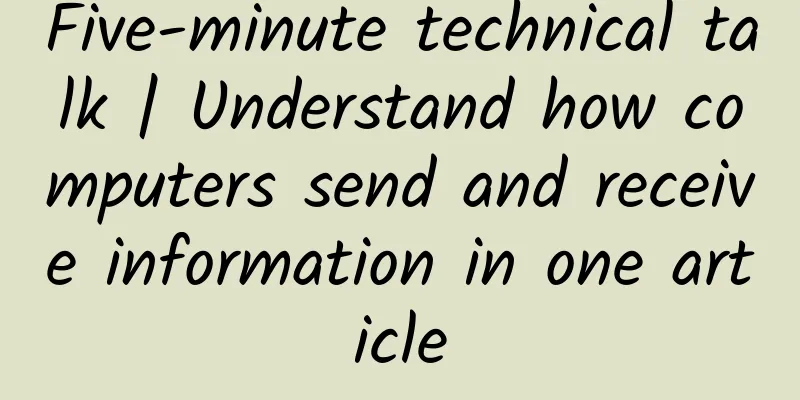Regarding "computing power", this article is worth reading

|
In today’s article, let’s talk about computing power. In the past two years, computing power has become a hot concept in the ICT industry, and it often appears in news reports and speeches by big names. So, what exactly is computing power? What categories does computing power include and what are their uses? What is the current state of global computing power development? Next, Xiaozaojun will give you a detailed scientific introduction. What is computing power?As we all know, the literal meaning of computing power is computing power. More specifically, computing power is the computing ability to achieve target output results by processing information data. We humans actually have this ability. We are calculating every moment in our lives. Our brain is a powerful computing engine. Most of the time, we do tool-free calculations by oral and mental arithmetic. However, this kind of computing power is a bit low. Therefore, when we encounter complex situations, we will use computing tools for deep calculations. In ancient times, our primitive tools were straw ropes and stones. Later, with the advancement of civilization, we had more practical computing tools such as counting sticks (a small stick used for calculations) and abacus, and the level of computing power continued to improve. In the 1940s, we ushered in a computing revolution. In February 1946, the world's first digital electronic computer ENIAC was born, marking the official entry of human computing power into the digital electronic age. ENIAC, 1946 Later, with the emergence and development of semiconductor technology, we entered the chip era. Chips became the main carrier of computing power. The world's first integrated circuit (chip), 1958 Time goes on. By the 1970s and 1980s, chip technology had made great progress under the guidance of Moore's Law. The performance of chips continued to improve and their size continued to decrease. Finally, computers were miniaturized and PCs (personal computers) were born. The world's first PC (IBM 5150), 1981 The birth of the PC is of great significance. It marks that IT computing power is no longer limited to serving a few large enterprises (mainframes), but is heading towards ordinary families and small and medium-sized enterprises. It successfully opened the door to the universal information age and promoted the popularization of informatization in the entire society. With the help of PC, people have fully felt the improvement in quality of life and production efficiency brought by IT computing power. The emergence of PC also laid the foundation for the subsequent vigorous development of the Internet. After entering the 21st century, computing power has once again ushered in a huge change. The symbol of this huge change is the emergence of cloud computing technology. Cloud Computing Before cloud computing, humans suffered from insufficient computing power in single-point computing (a mainframe or a PC independently completing all computing tasks) and had tried distributed computing architectures such as grid computing (breaking down a huge computing task into many small computing tasks and assigning them to different computers to complete). Cloud computing is a new attempt at distributed computing. Its essence is to package and aggregate a large number of scattered computing resources to achieve higher reliability, higher performance, and lower cost computing power. Specifically, in cloud computing, computing resources such as the central processing unit (CPU), memory, hard disk, and graphics card (GPU) are combined and formed into a virtual and infinitely scalable "computing resource pool" through software. If users have computing power needs, the "computing power resource pool" will dynamically allocate computing power resources, and users will pay on demand. Compared with users purchasing equipment, building their own computer rooms, and performing operations and maintenance themselves, cloud computing has obvious cost-effectiveness advantages. Cloud computing data center After computing power was cloudified, data centers became the main carrier of computing power. The scale of human computing power began a new leap. Classification of computing powerThe emergence of cloud computing and data centers is due to the continuous deepening of informatization and digitalization, which has triggered a strong demand for computing power in the entire society. These demands come from the consumer sector (mobile Internet, drama watching, online shopping, taxi-hailing, O2O, etc.), the industry sector (industrial manufacturing, transportation and logistics, financial securities, education and medical care, etc.), and the urban governance sector (smart city, one-card access, city brain, etc.). Different computing power applications and demands have different algorithms. Different algorithms also have different requirements for the characteristics of computing power. Generally, we divide computing power into two categories: general computing power and dedicated computing power. You may have heard that the chips responsible for outputting computing power are divided into general-purpose chips and special-purpose chips. CPU processor chips like x86 are general-purpose chips. The computing tasks they can complete are diverse and flexible, but they consume more power. Dedicated chips mainly refer to FPGA and ASIC. FPGA is a programmable integrated circuit. It can change the logic structure of the internal chip through hardware programming, but the software is deeply customized to perform specialized tasks. ASIC is an application-specific integrated circuit. As the name suggests, it is a chip customized for professional use, and most of its software algorithms are solidified on the silicon chip. ASIC can complete specific computing functions and has a relatively simple function, but its energy consumption is very low. FPGA is between general-purpose chips and ASIC. Let’s take Bitcoin mining as an example. In the past, people used PCs (x86 general-purpose chips) to mine, but later on, mining became more and more difficult and the computing power was insufficient. So, people started using graphics cards (GPUs) to mine. Later, graphics cards consumed too much energy, and the value of the mined coins was not enough to cover the electricity bill, so they started using FPGA and ASIC cluster arrays to mine. In data centers, computing tasks are also divided into basic general computing and HPC high-performance computing (High-performance computing). HPC computing is further divided into three categories: Scientific computing: physical chemistry, meteorology and environmental protection, life sciences, oil exploration, astronomical detection, etc. Engineering computing: computer-aided engineering, computer-aided manufacturing, electronic design automation, electromagnetic simulation, etc. Intelligent computing: artificial intelligence (AI) computing, including machine learning, deep learning, data analysis, etc. Everyone should have heard of scientific computing and engineering computing. These professional scientific research fields generate a large amount of data and require extremely high computing power. Take oil and gas exploration as an example. Oil and gas exploration, in simple terms, is to do CT scans on the surface. For a project, the raw data often exceeds 100TB, and may even exceed 1PB. Such a huge amount of data requires massive computing power to support it. We need to focus on intelligent computing. AI artificial intelligence is currently the development direction that the whole society focuses on. No matter which field it is, people are studying the application and implementation of artificial intelligence. The three core elements of artificial intelligence are computing power, algorithms and data. As we all know, AI is a big consumer of computing power. In AI computing, there are many matrix or vector multiplication and addition operations involved, which are highly specialized, so it is not suitable to use CPU for computing. In real applications, people mainly use GPU and the special chips mentioned above for computing. In particular, GPU is the main force of AI computing power. Although GPU is a graphics processor, its number of GPU cores (logical operation units) far exceeds that of CPU. It is suitable for sending the same instruction stream to multiple cores in parallel and using different input data for execution, so as to complete a large number of simple operations in graphics processing or big data processing. Therefore, GPU is more suitable for processing computing-intensive and highly parallelized computing tasks (such as AI computing). In recent years, due to the strong demand for AI computing, the country has also specially built many intelligent computing centers, that is, data centers dedicated to intelligent computing. Chengdu Intelligent Computing Center (Photo from the Internet) In addition to the intelligent computing center, there are now many supercomputing centers. Supercomputing centers are equipped with supercomputers such as the Tianhe-1, which are specially designed to undertake various large-scale scientific and engineering computing tasks. (Picture from the Internet) The data centers we usually see are basically cloud computing data centers. The tasks are quite complex, including basic general computing and high-performance computing, as well as a large amount of heterogeneous computing (computing methods that use different types of instruction sets at the same time). As the demand for high-performance computing increases, the proportion of dedicated computing chips is gradually increasing. TPU, NPU, and DPU, which have gradually become popular in the past few years, are actually dedicated chips. The "computing power offloading" that we often hear about now is not actually deleting the computing power, but transferring many computing tasks (such as virtualization, data forwarding, compression storage, encryption and decryption, etc.) from the CPU to chips such as NPU and DPU, thereby reducing the computing power burden of the CPU. In recent years, in addition to basic general computing power, intelligent computing power, and supercomputing power, the scientific community has also seen the emergence of the concept of cutting-edge computing power, mainly including quantum computing, photonic computing, etc., which deserves attention. Measuring HashrateSince computing power is a "capability", there are of course indicators and benchmark units to measure its strength. The units that everyone is more familiar with should be FLOPS, TFLOPS, etc. In fact, there are many indicators to measure computing power, such as MIPS, DMIPS, OPS, etc. MFLOPS, GFLOPS, TFLOPS, PFLOPS, etc. are all different orders of magnitude of FLOPS. The specific relationship is as follows: Floating point numbers have different specifications: FP16, FP32, and FP64 There is a huge difference in computing power between different computing power carriers. In order to help you better understand this difference, Xiaozaojun has made a computing power comparison table: Earlier we mentioned general computing, intelligent computing, and supercomputing. From a trend perspective, the computing power of intelligent computing and supercomputing is growing much faster than general computing. According to GIV statistics, by 2030, general computing power (FP32) will increase 10 times to 3.3 ZFLOPS. And AI intelligent computing power (FP16) will increase 500 times to 105 ZFLOPS. The Current State and Future of Computing PowerAs early as 1961, John McCarthy, the "father of artificial intelligence", proposed the goal of utility computing. He believed that "one day, computing may be organized as a public utility, just as the telephone system is a public utility." Today, his vision has become a reality. Under the digital wave, computing power has become a public basic resource like water and electricity, and data centers and communication networks have also become important public infrastructure. This is the result of more than half a century of hard work in the IT and communication industries. For the entire human society, computing power is no longer a technical concept. It has risen to the economic and philosophical dimensions, becoming the core productivity in the digital economy era and the cornerstone of the digital transformation of the entire society. The lives of each of us, the operation of factories and enterprises, and the operation of government departments are inseparable from computing power. In key areas such as national security, national defense construction, and basic discipline research, we also need massive computing power. Computing power determines the speed of digital economic development and the height of social intelligence development. According to data jointly released by IDC, Inspur Information, and Tsinghua University Global Industry Research Institute, for every 1 point increase in the computing power index, the digital economy and GDP will increase by 3.5‰ and 1.8‰ respectively. The computing power scale and economic development level of countries around the world have shown a significant positive correlation. The larger the computing power scale of a country, the higher the level of economic development. Ranking of computing power and GDP of countries around the world (Source: Chi Jiuhong, speech at Huawei Computing Era Summit) In the field of computing power, the competition between countries is becoming increasingly fierce. In 2020, my country's total computing power reached 135 EFLOPS, a year-on-year increase of 55%, exceeding the global growth rate by about 16 percentage points. At present, our absolute computing power ranks second in the world. However, from a per capita perspective, we do not have an advantage and are only at the level of a medium-sized computing power country. Comparison of per capita computing power in various countries around the world (Source: Tang Xiongyan, speech at Huawei Computing Era Summit) Especially in core computing technologies such as chips, we still have a big gap with developed countries. Many bottleneck technologies have not been solved, which seriously affects our computing security and thus affects national security. Therefore, there is still a long way to go and we need to continue to work hard. Recently, the opponent has set his sights on lithography machines (picture from the Internet) In the future society, informatization, digitization and intelligence will be further accelerated. The advent of the era of intelligent interconnection of all things, the introduction of a large number of intelligent IoT terminals, and the implementation of AI intelligent scenarios will generate unimaginable massive amounts of data. These data will further stimulate the demand for computing power. According to Roland Berger's forecast, from 2018 to 2030, the demand for computing power for autonomous driving will increase 390 times, the demand for smart factories will increase 110 times, and the per capita computing power demand in major countries will increase 20 times from less than 500 GFLOPS today to 10,000 GFLOPS in 2035. According to the forecast of Inspur Artificial Intelligence Research Institute, by 2025, the global computing power scale will reach 6.8 ZFLOPS, a 30-fold increase compared with 2020. A new round of computing power revolution is accelerating. ConclusionComputing power is such an important resource, but in fact, there are still many problems in our utilization of computing power. For example, there are issues with computing power utilization and the balance of computing power distribution. According to IDC data, the utilization rate of small computing power dispersed by enterprises is currently only 10%-15%, which is a huge waste. Moore's Law has been slowing down since 2015, and the growth rate of computing power per unit of energy consumption has gradually been outpaced by the growth rate of data volume. While we continue to tap the potential of chip computing power, we must also consider the resource scheduling of computing power. So, how do we schedule computing power? Can existing communication network technology meet the scheduling needs of computing power? Stay tuned for the next episode: What exactly is the “computing power network”? |
<<: Shocked! Is it possible to disguise yourself on the Internet?
>>: I have seven solutions for implementing real-time web messaging
Recommend
Juniper Networks MIST AI network solution gives network engineers "superpowers"!
[51CTO.com original article] Under the night, the...
TTCLOUD: San Jose high-defense server $59/month, dual E5-2620v2/16GB/500G SSD/100M unlimited traffic
TTCLOUD is a relatively new foreign hosting sales...
New infrastructure has boosted the multi-billion-dollar 5G optical module market, and the high-end sector urgently needs to increase the domestic production rate
2020 is a big year for 5G capital expenditure. Be...
HmbCloud: $4.99/month KVM-1GB/10GB/500GB/Los Angeles (CN2 GIA)
HmbCloud is called Half Moon Bay. According to th...
Top 10 SDN Solutions of 2018 (So Far)
Software is the front and center of the network w...
[6.18] Moack: $35.64/month-2xE5-2630L/32GB/1TB/10M bandwidth/South Korea server
Moack.co.kr is a Chinese merchant who mainly sell...
IPv6 neighbor discovery, address duplication detection, and router discovery mechanisms, learn about them in one minute
1. IPv6 Basics IPv6 (Internet Protocol Version 6)...
5 web trends you need to know about in 2021
On December 14, 2020, a massive network outage ca...
[Black Friday] Zgovps: $12.9/year-1GB/20GB/2TB/Japan IIJ/Germany/Los Angeles AS4837, etc.
Zgovps also released a promotion during this year...
The entire network discloses IP locations, and your location is exposed
Author | Lu Yao Reviewer | Yun Zhao Recently, IP ...
China has been preparing for IPv6 for more than a decade, but why is IPv4 still the mainstream?
It is understood that IPv6 was first introduced i...
The United States suddenly changed its mind and allowed Huawei to cooperate in formulating 5G standards, only to shoot itself in the foot because of the Entity List
This article is reprinted with permission from AI...
From 4G to 5G, my country's mobile communication highway is getting wider and wider
Since the advent of mobile communications, humans...
.com domain prices expected to rise for first time in eight years
According to foreign media reports, ICANN, the or...
The live streaming of selling goods is so smooth, it turns out that this technical system is supporting it!
1. Introduction Hi, everyone. I am your Xiaomi. T...









